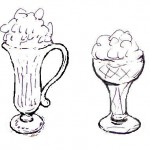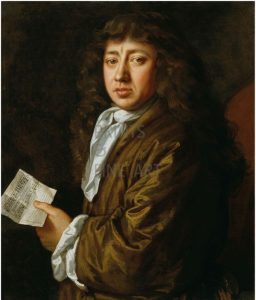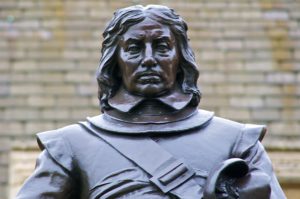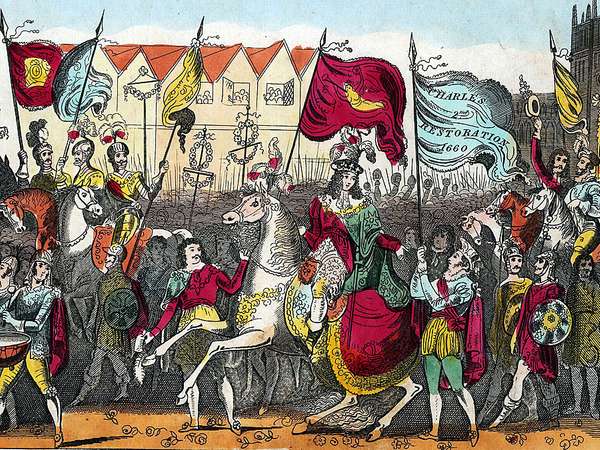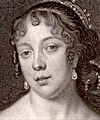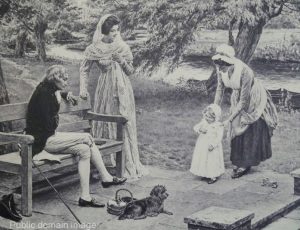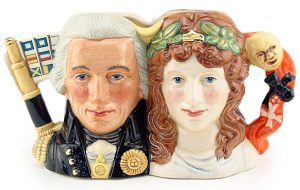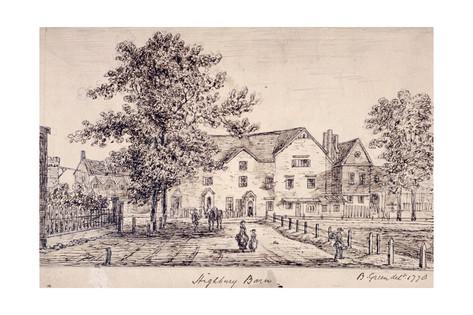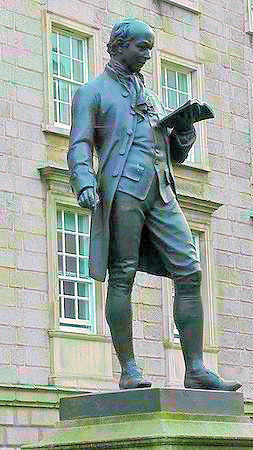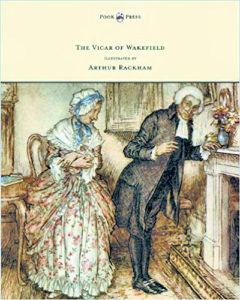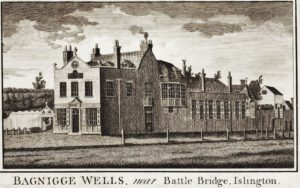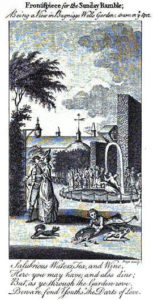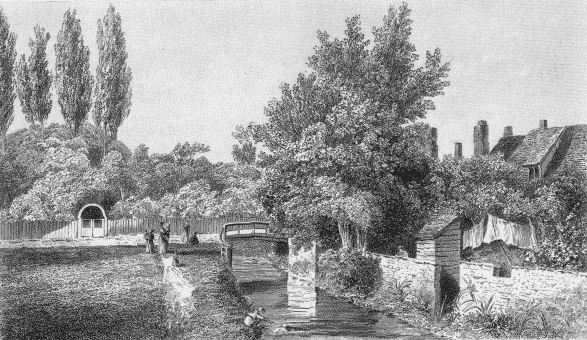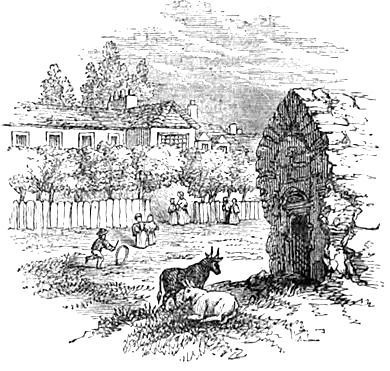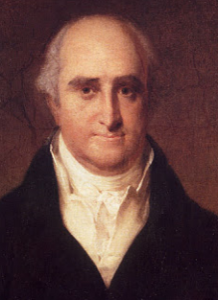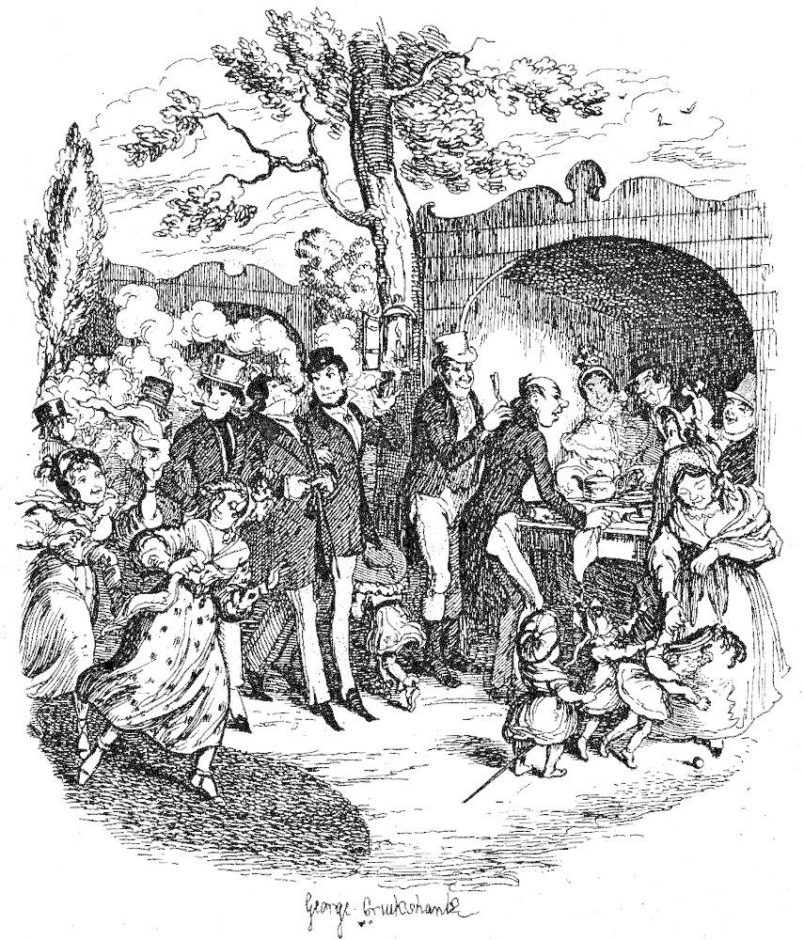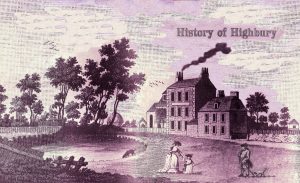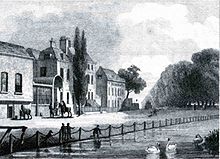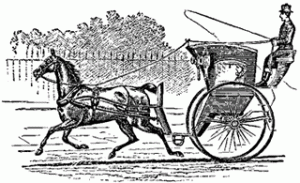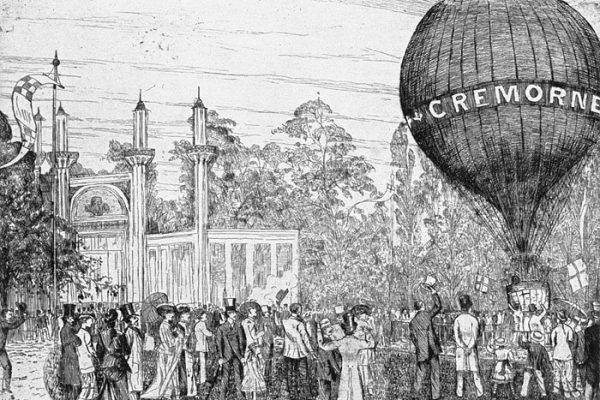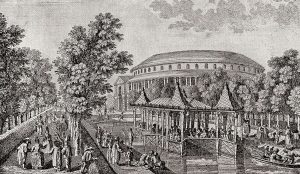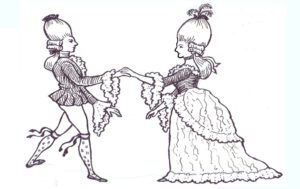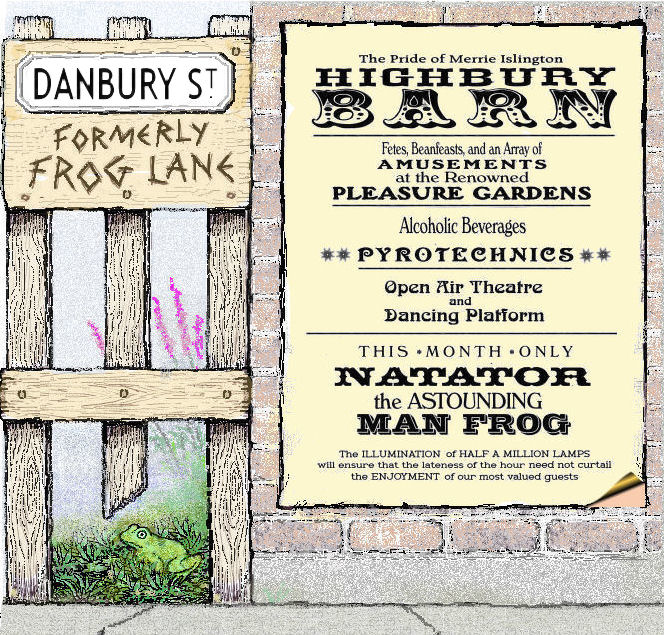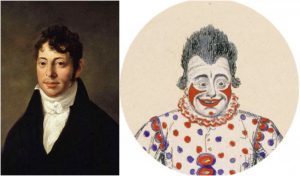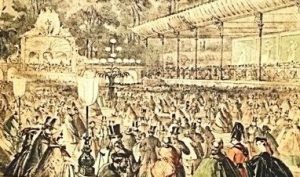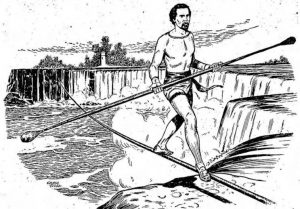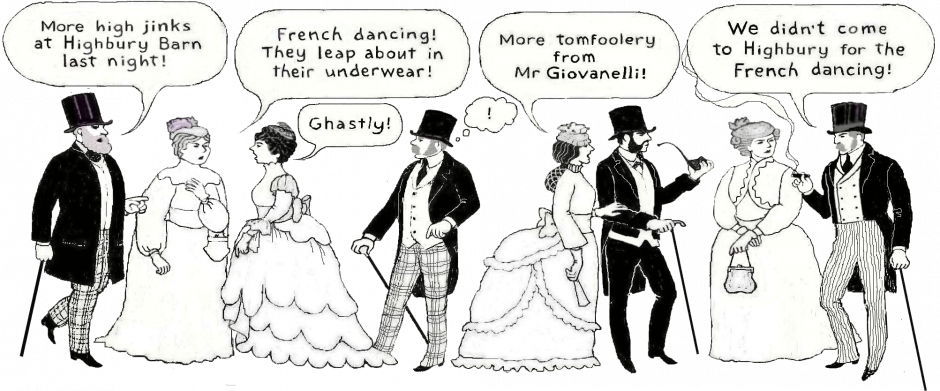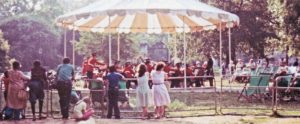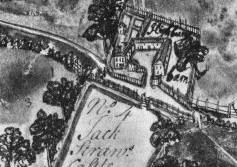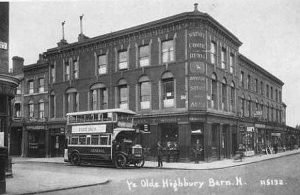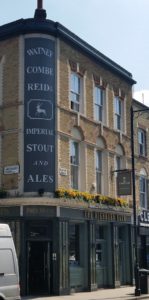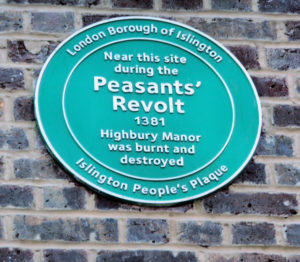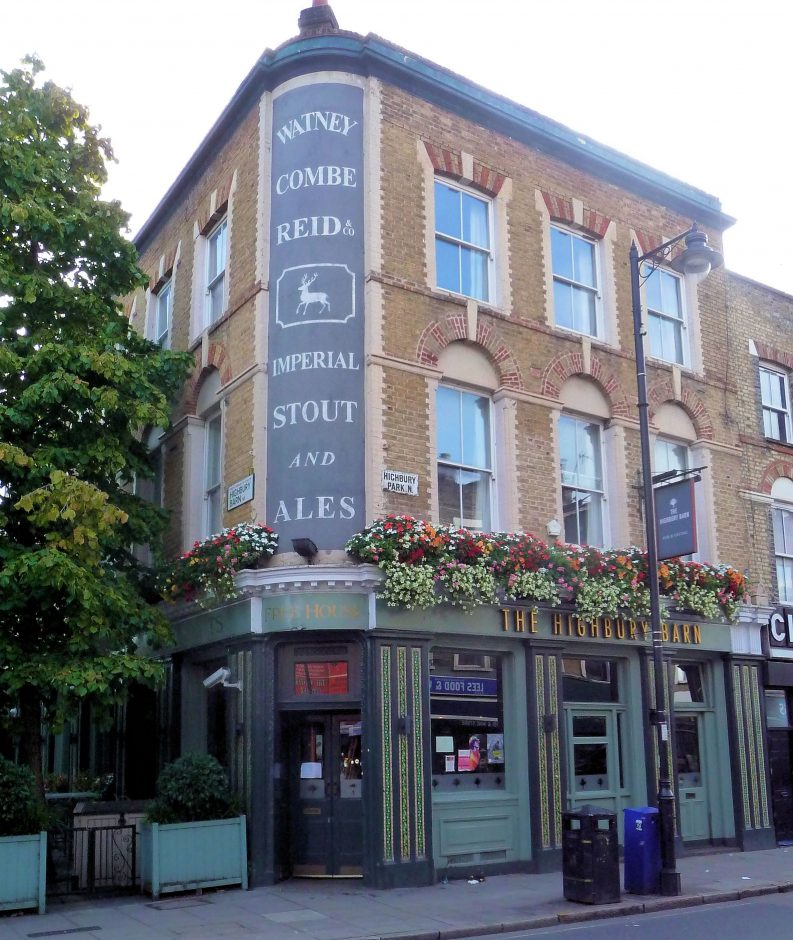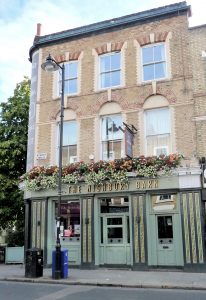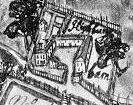 When Highbury’s Manor House was destroyed in the Peasants’ Revolt of 1381, its adjoining farm was spared. In the years that follow, the former grange of the Knights of St John becomes known as Highbury Barn.
When Highbury’s Manor House was destroyed in the Peasants’ Revolt of 1381, its adjoining farm was spared. In the years that follow, the former grange of the Knights of St John becomes known as Highbury Barn.
Rural Highbury
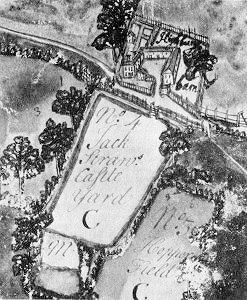
Highbury Barn farm, across the road from the site of the burned Manor House (“Jack Straw’s Castle Yard”). Keith Sugden, History of Highbury
Land all round the old Manor House farm remains rural countryside for hundreds of years after the Peasants’ Revolt. Cattle from the rest of the country, destined for London’s Smithfield Market, graze in the fields of Highbury before the final leg of their journey.
Londoners come to rural Highbury for its ‘good air’ & its dairy delights. As well as Holloway cheesecakes, hawked daily in the city, dairy delights come from Cream Hall, a farm on present-day Legard Road, & Highbury Barn. In 1740, a small Cake & Ale House opens in the barn, offering cakes dipped in frothing cream, custards, ale brewed on the spot, & syllabubs.
Originating in Tudor times, syllabubs were a mixture of milk fresh from the cow, ale & cider. By the time of Mrs Beeton (1861) they consist of sugar, lightly curdled with wine, put in a bowl & placed under a cow; milking creates froth on top.
For syllabub recipes & Dr Hale’s ‘syllabub pumping engine’ : www.historicfood.com/Syllabub Recipes.htmthe
britishfoodhistory.wordpress.com/2013/01/03/syllabubs
In the great entertainment given at Kenilworth by the Earl of Leicester to Queen Elizabeth in 1575, a minstrel, reflecting on the Islington dairies, proposed that the arms of Islington should be
‘three milk tankards proper on a field of clouted cream, three green cheeses upon a shelf of cake bread, a furmenty bowl, stuck with horn spoons, and, for supporters, a grey mare (used to carry the milk tankards) and her silly foal; the motto, “Lac caseus infans,” or “Fresh cheese and cream”, the milkwives cry in London streets.’ British History Online . http://www.british-history.ac.uk/old-new-london/vol2/pp251-268
Tea
Tea has quite a role to play in the history of Highbury Barn. The availability of tea today is largely taken for granted, but there was a time when it had yet to be introduced to the western world.
On 25 September 1660, noted diarist Samuel Pepys drinks his first cup of tea. He has been discussing foreign affairs in the Navy Office with a group that includes Sir Richard Ford, former Commissioner in The East India Company, who “.. afterwards did send for a Cupp of Tee (a China drink) of which I never drank before”.
Samuel Pepys is a coffee drinker. He is a regular in the London Coffeehouses, where one early sampler likened the drink of the time to a “syrup of soot and the essence of old shoes”.
https://publicdomainreview.org/2013/08/07/the-lost-world-of-the-london-coffeehouse/ Dr Matthew Green‘s immersive walks include The Lost World of the London Coffeehouse. See our resources page for more.
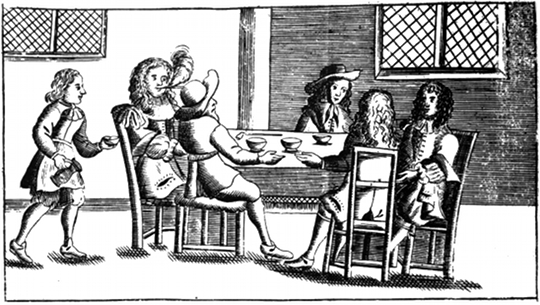
Coffeehouse print, Pepys era.
.
At this time the Britons’ national beverage is ale, but coffee is becoming more popular. This China drink, Tee, is a novelty to Pepys, as it will be for most of the country. China tea has been introduced to other parts of Europe – Venice, Holland, Portugal & France…
“It was remarkably expensive: advertisements in the press in 1660 give prices for ‘tea or tay’ from two to six pounds a pound. This is ten times the cost of coffee, making it a very expensive drink indeed. To illustrate how expensive this was, compare the price of tea with that of sherry. In 1660 Pepys spent a shilling to buy a dozen bottles of sack (sherry or other white wine from Spain). At this rate, a pound of tea was worth the same as 1440 bottles of sherry. Cheap sherry costs about £7 in my local supermarket, making a pound of tea over £10,000 in today’s money.”
“Pepys didn’t much like tea. It isn’t clear what sort he drank, though it was likely to be a green tea from China. In any case, every subsequent mention of tea in the Diary is deeply suspicious of it…’ HISTORY OF TEA PROJECT AT QUEEN MARY UNIVERSITY OF LONDON https://qmhistoryoftea.wordpress.com/2015/07/10/elizabeth-pepyss-potticary-tea/
Change of Government
There has been a change of Government. Pepys’ cup of tea is drunk as the country recovers from decades of repression following two civil wars, the execution of King Charles I, & Oliver Cromwell’s regime as Lord Protector. Puritan rule is ended, a time when
“…pointless enjoyment was frowned upon. Cromwell shut many inns and the theatres were all closed down. Most sports were banned. Boys caught playing football on a Sunday could be whipped as a punishment. Swearing was punished by a fine, though those who kept swearing could be sent to prison.
Sunday became a very special day under the Puritans. Most forms of work were banned. Women caught doing unnecessary work on the Holy Day could be put in the stocks. Simply going for a Sunday walk (unless it was to church) could lead to a hefty fine.
Cromwell believed that women and girls should dress in a proper manner. Make-up was banned. Puritan leaders and soldiers would roam the streets of towns and scrub off any make-up found on unsuspecting women. Too colourful dresses were banned.
Cromwell banned Christmas as people would have known it then. In London, soldiers were ordered to go round the streets and take, by force if necessary, food being cooked for a Christmas celebration. ”
https://www.historylearningsite.co.uk/stuart-england/life-in-england-under-oliver-cromwell
King Charles II
After Cromwell’s death in 1658, his son Richard leaves in 1659. The exiled Charles II is asked to return as King of England. He agrees, & the monarchy is restored. Music, sport, science & the arts are no longer banned. In the restored theatre under Charles II, women now perform. All parts had previously been taken by men.
“The Royal Court was notorious for its wine, women and song, and Charles became known as the “Merry Monarch” for his indulgence in hedonistic pleasures.”
https://www.biography.com/people/charles-ii-of-england-39462
https://www.britannica.com/place/United-Kingdom/The-later-Stuarts#ref483136
https://britishheritage.com/charles-ii-and-the-restoration/
Queen Catherine
In 1662 the newly crowned King marries a Portuguese princess, Catherine of Braganza. Tea is the favourite drink at the Portuguese court, & dowry gifts to King Charles from Catherine’s father for their wedding include a chest of tea. The young queen’s influence has much to do with tea becoming the fashionable drink at the English court.
UK Tea & Infusions Association . https://www.tea.co.uk/catherine-of-braganza
” Queen Catharine was responsible for popularising tea-drinking in England. When she first arrived in Portsmouth on 13 May 1662, she asked for a cup of tea. This baffled the English as the drink was barely known at this time; the national beverage was ale. “
http://www.bbc.co.uk/pressoffice/pressreleases/stories/2003/10_october/23/charles_ii_mistresses.pdf
By June 1667, tea is not only considered fashionable, but healthful and medicinal as well.
‘I went away and by coach home, and there find my wife making of tea, a drink which Mr. Pelling, the Potticary, tells her is good for her cold and defluxions.’ Samuel Pepys
By the early 1700’s, tea is being consumed in this country in the privacy of drawing rooms or drunk – by men only – in coffeehouses.
The Fashion for Tea Gardens
Tea Gardens Appear in Britain
Dutch inns provided the first restaurant service of tea (c 1680). Tavern owners would furnish guests with a portable tea set complete with a heating unit. The independent Dutchman would then prepare tea for himself and his friends outside in the tavern’s garden.
https://warsoon.wordpress.com/
“Experiencing the Dutch “tavern garden teas”, the English developed the idea of Tea Gardens.
Here ladies and gentlemen took their tea out of doors surrounded by entertainment such as orchestras, hidden arbors, flowered walks, bowling greens, concerts, gambling, or fireworks at night. It was at just such a Tea Garden that Lord Nelson, who defeated Napoleon by sea, met the great love of his life, Emma, later Lady Hamilton.
“Women were permitted to enter a mixed, public gathering for the first time without social criticism. As the gardens were public, British society mixed here freely for the first time, cutting across lines of class and birth. so from the tea gardens came the idea of the tea dance, which remained fashionable in Britain until World War II when they disappeared from the social scene. Famous English composer James Hook’s songs were regularly performed at the main London pleasure gardens: Marylebone, Covent, Vauxhall, Ranelagh.
Tipping as a response to proper service developed in the Tea Gardens of England. Small, locked wooden boxes were placed on the tables throughout the Garden. Inscribed on each were the letters “T.I.P.S.” which stood for the sentence “To Insure Prompt Service”. If a guest wished the waiter to hurry (and so insure the tea arrived hot from the often distant kitchen) he dropped a coin into the box on being seated “to insure prompt service”. Hence, the custom of tipping servers was created.”
http://www.gol27.com/HistoryTeaEngland.html
Lord Nelson spent his last two years at Merton, where the River Wandle meanders gently through the property. Visit Morden Hall Park, owned by the National Trust, with a Garden Centre & cafeteria. https://www.wimbledonguardian.co.uk/news/15447083.one-of-britains-greatest-naval-heroes-horatio-nelson-has-roots-in-merton-and-you-can-walk-in-his-footsteps/
* Highbury Barn, 1740-1871 – From Dairy Farm to Tea Garden
Highbury has its dairy delights and that ‘good air’, which people will travel some distance from sooty inner London to breathe. Highbury Barn, an Islington dairy farm with a small cake and ale house, now takes on the mantle of the tea garden. It offers the public, already drawn by its syllabubs and the rural idyll, this newly fashionable tea.
” Highbury Barn is visited by members of the non-conformist Highbury Society, who walk to it ‘from all parts of London and its surroundings.’ ” History of Highbury, Keith Sugden
Highbury Barn : Oliver Goldsmith Ate Here
Oliver Goldsmith, Irish poet, novelist & author of ‘She Stoops to Conquer’, lodged at Canonbury Tower in the 1760s. ” Goldsmith had written ‘The Vicar of Wakefield’ while hiding from his creditors in London. It was at this time that he often took lunch at nearby Highbury Barn, a haunt of the non-conformist Highbury Society, whose members would walk there from all over London.” https://www.jdwetherspoon.com/pub-histories/england/london/the-white-swan-islington
 “Three or four of his intimate friends rendezvoused at his chambers, to breakfast, about ten o’clock in the morning; at eleven they proceeded by the City-Road, and through the fields to Highbury Barn to dinner; about six o’clock in the evening they adjourned to White Conduit House to drink tea; and concluded the evening by supping at the Grecian or Temple Exchange Coffeehouses, or at the Globe, in Fleet Street”.Keith Sugden, History of Highbury
“Three or four of his intimate friends rendezvoused at his chambers, to breakfast, about ten o’clock in the morning; at eleven they proceeded by the City-Road, and through the fields to Highbury Barn to dinner; about six o’clock in the evening they adjourned to White Conduit House to drink tea; and concluded the evening by supping at the Grecian or Temple Exchange Coffeehouses, or at the Globe, in Fleet Street”.Keith Sugden, History of Highbury
Goldsmith’s Canonbury Tower chambers were in Islington’s oldest building; see John Rogers’ Secret Islington Walking Tour ( at 12.39), Youtube
* Bagnigge Wells, 1757-1842 – From Health Spa to Tea Garden
Islington’s many wells & spas also attract the populace. Bagnigge Wells, a health spa to the southeast of Highbury Barn, could be reached by boat via the River Fleet (now King’s Cross Road). Its health-giving waters, and those of Sadler’s Wells, Clerkenwell, Mus-well, St Pancras Well & others persuade the public to visit the district.
” There were two springs at Bagnigge wells, which became a very fashionable spa in the 18th century. The original site of the spa, Bagnigge House, was claimed to have been owned by Nell Gwynne the mistress of Charles II. In the rear garden ran the Fleet river, known as the river of “wells” because of the number of wells associated with it. Two wells were originally sunk around 1757 and had chalybeate properties. The wells became a very popular resort for taking “the waters” and for tea drinking, where the fashionable of London were wont to gather.” http://www.davidfurlong.co.uk/holywellslond.htm
“Two other retreats visited by Nell and the King were a house in Bagnigge, near Kings Cross and Windsor. On summer mornings they would swim in the Fleet River, a tributary of the Thames.”
https://thefreelancehistorywriter.com/2012/08/24/nell-gwyn-mistress-of=king=charles-ii-of-england-3
“Food and entertainments depended on the time of day. In Bagnigge Wells, for example, morning visitors tended to be invalids who would drink the mineral waters and partake of an early breakfast. The restorative qualities of the waters were much praised… *
Ye gouty old souls and rheumatics crawl on,
Here taste these blest springs, and your tortures are gone;”
“The citizens, their wives and daughters, came for their afternoon outing; the long room if the weather threatened, and the arbours if the sun shone, were filled with sober parties of shopkeepers or with boys and their sweet hearts, drinking tea and eating the bread and butter and the buns baked on the ground for which the place was famous. Negus was another of the products of Bagnigge held in much favour, and cider and ale for the more jovial spirits who smoked under the shade of the Fleet willows and watched games of skittles and Dutch pins which were played in the eastern part of the gardens during the long summer evenings.”
18th & 19th Century Pleasure and Tea Gardens in London
“The wells at Bagnigge consisted of 2 different types of water – one of which was noted for being a purgative. It is interesting how many holy wells & spa wells had this type of effect & that this made them very popular – presumably because of the lack of .. vegetables in the common diet.”
Over the UnderGround/London’s Green and Pleasant Land https://ukgardenfiend.wordpress.com/tag/bagnigge-well/
The Pindar of Wakefield pub, now The Water Rats, dates to 1517. One-time Pindar of Wakefield, landlord George Green was said to have had links to Robin Hood
https://venturesintopography.wordpress.com/2011/02/03/the-lost-pleasure-gardens-of-finsbury-and-pentonville/ The walk by John Rogers and Nick Papadimitriou to some of the area’s historic spas, baths and wells is on a Resonance FM podcast which you can download at the end of this piece.
https://westernpublicpleasuregardens.blogspot.co.uk/
* White Conduit House, 1730-1820s – From Tavern to Tea Garden
White Conduit House lies between Highbury Barn & Bagnigge Wells. The source of the White Conduit, a spring which supplied water to Greyfriars Priory, Newgate & the Charterhouse Monastery, was enclosed in 1641. The tavern dates from 1649.
“Here again is an example of a pleasure resort developing partially from an ale-house, for the legend is that the White Conduit House was at first a small tavern, the finishing touches to which were given, to the accompaniment of much hard drinking, on the day Charles I lost his head … reconstructed somewhere about 1745, … its popularity seems to date from the tenure of its new proprietor, Robert Bartholomew, who acquired it in 1754, and to have continued unabated till nearly the end of the century.”
 On taking over the property, Mr Bartholomew announces:
On taking over the property, Mr Bartholomew announces:
” For the better accommodation of ladies and gentlemen, I have completed a long walk, with a handsome circular fish-pond, a number of shady pleasant arbours, inclosed with a fence seven feet high to prevent being the least incommoded from people in the fields; hot loaves and butter every day, milk directly from the cows, coffee, tea, and all manner of liquors in the greatest perfection; also a handsome long room, from whence is the most copious prospects and airy situation of any now in vogue.
I humbly hope the continuance of my friends’ favours, as I make it my chief study to have the best accommodations, and am, ladies and gentlemen, your obliged humble servant, Robert Bartholomew.
Note. My cows eat no grains, neither any adulteration in milk or cream. ”
“White Conduit Loaves” was one of the common London street-cries, before the French war raised the price of bread.” British History Online . http://www.british-history.ac.uk/old-new-london/vol2/pp279-289
Cricketing Connections
It was much later, in 1730, that a pleasure gardens and tearooms opened called the White Conduit; this resort was patronised by the genteel together with their servants into the 1820s. It provided entertainment such as balloon flights, fireworks, singing and dancing. It had a cricket ground where Thomas Lord, of Lord’s cricket ground fame, was groundsman. This was why during the seventeenth and eighteenth centuries Islington was considered an invigorating pleasure resort.” http://www.olivercromwell.org/islington.htm
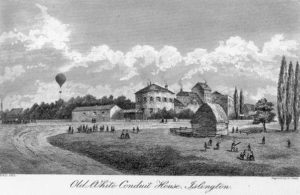 Thomas Lord was groundsman & practice bowler at the White Conduit Cricket Club. In the search for a less open ground for the club, he moved it to three other sites. Each time the turf was lifted from the old ground, taken to prepared soil on the new site, relayed & surrounded by a fence. ‘People used to refer to his turf as the most travelled grass in the city.’
Thomas Lord was groundsman & practice bowler at the White Conduit Cricket Club. In the search for a less open ground for the club, he moved it to three other sites. Each time the turf was lifted from the old ground, taken to prepared soil on the new site, relayed & surrounded by a fence. ‘People used to refer to his turf as the most travelled grass in the city.’
He ran the club at the second site, Dorset Fields to the west of Baker Street, for 12 years. The third move was to a new ground in St Johns Wood. This land was then required by the government for the building of the Regents Canal, so Thomas Lord’s final move took him and the MCC to its current site.
The White Conduit Cricket Club merged with the Marylebone Cricket Club to form the MCC.
White Conduit Connections : Oliver Goldsmith
Oliver Goldsmith, towards the close of 1762, removed to ‘Merry Islington,’ then a country village, though now swallowed up in omnivorous London. In this neighbourhood he used to take his solitary rambles, sometimes extending his walks to the gardens of the ‘White Conduit House,’ so famous among the essayists of the last century.” Washington Irving, Life of Goldsmith.
“After having surveyed the curiosities of this fair and beautiful town (Islington), I proceeded forward, leaving a fair stone building on my right. Here the inhabitants of London often assemble to celebrate a feast of hot rolls and butter. Seeing such numbers, each with their little tables before them, employed on this occasion, must no doubt be a very amusing sight to the looker-on, but still more so to those who perform in the solemnity.” Oliver Goldsmith
Joolz Guides’ Marvellous, Nostalgic London Walks – Barnsbury – shows a glimpse of the White Conduit’s original site on White Conduit Fields opposite the Albion Pub (the former Albion Tea House). In another walk, Non-Touristy Things to do in London – Dickens Museum & Foundlings Hospital, one image is a plaque tracing The White Conduit to Lambs Conduit Street. Waters coming down from the heights of Islington were here on their way to the Greyfriars Priory.
London’s Little Italy & the Legends of Islington (4K) — John Rogers, Another memorable London walk with writer & film-maker John Rogers, author of The Lost Byway, including a view of White Conduit House & the possible site of the original white conduit.
Hampshire History – Thomas Lord, Founder of Lord’s Cricket Ground, is Buried in West Meon
White Conduit Fields : Wikipedia The home & history of early cricket & its connection with Islington
White Conduit : London Remembers . Aiming to Capture All Memorials in London
Socializing at The Tea Gardens
Charles Dickens captures the feel of a summer tea garden crowd, possibly at Jack Straw’s Castle in Hampstead.
‘Sketches by Boz’ – London tea garden
“The heat is intense this afternoon, and the people, of whom there are additional parties arriving every moment, look as warm as the tables which have been recently painted, and have the appearance of being red-hot. What a dust and noise! Men and women — boys and girls — sweethearts and married people — babies in arms, and children in chaises — pipes and shrimps— cigars and periwinkles — tea and tobacco.
Gentlemen, in alarming waistcoats and steel watch-guards, promenading about, three abreast, with surprising dignity (or as the gentleman in the next box facetiously observes, “cutting it uncommon fat!”) — ladies, with great, long, white pocket-handkerchiefs like small table-cloths, in their hands, chasing one another on the grass in the most playful and interesting manner, with the view of attracting the attention of the aforesaid gentlemen”..
***
It is difficult now to imagine a similar tea garden on Kings Cross Road (The River Fleet), another in nearby Pentonville & a third in Highbury, each surrounded largely by open countryside. But fewer than 300 years ago, the fresh air & greenery of these & other tea gardens are a draw for Londoners. They will take the trouble to put on their finest clothes (no ‘smart/casual’) & travel some distance to enjoy what is on offer.
Improvements to Highbury Barn
1770: Mr Willoughby the Younger, Highbury Barn’s new owner, adds to its attractions. He lays out a bowling-green, a trap-ball ground* & a garden with a small plantation of hops at one end for a recently erected ‘ale & table-beer brewery’.
*See Knurr and Spell in Wikipedia for a description of this game.
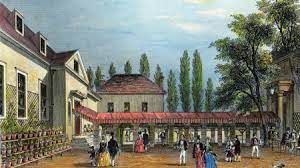 The demand for home-brewed beer becomes substantial. By 1814, Mr Willoughby has built a larger brewery in Lower Holloway to cater for it. Next door the Highbury Brewery Tap, now The Lamb on Holloway Road, still brews beer on the premises. Patrons can look down on the process through a glass panel in the floor.
The demand for home-brewed beer becomes substantial. By 1814, Mr Willoughby has built a larger brewery in Lower Holloway to cater for it. Next door the Highbury Brewery Tap, now The Lamb on Holloway Road, still brews beer on the premises. Patrons can look down on the process through a glass panel in the floor.
The barn adjoining the former Cake & Ale House is ‘fitted up with a handsome exterior‘ in the early 1800’s. It is added to the Tavern’s premises & called the Highbury Assembly House.
Under new proprietors John & Archibald Hinton, the farm is renamed Highbury Barn. It gains a reputation for hosting large gatherings. In 1841 a newspaper ad presents The Highbury Barn Tavern as catering for ‘parties requiring banquets, fancy fairs or galas of any magnitude’, with private rooms for small parties.
Organisations such as the Wheelwrights, the Fancy Cabinetworkers & the Diamond Jewellers Society now utilize The Highbury Barn Tavern. In 1841 The Hintons’ huge tent caters for 3000 at the London Victuallers Society’s annual dinner & ball. Transport at the time was by foot or as paying passengers in a horse-drawn coach or hansom cab. Imagine 3000 guests arriving for the dinner & ball, thronging the local streets. There must have been a happy buzz around them not unlike the sound that builds up before the Arsenal’s games, as friends & families chat… everyone feeling good, no-one having won or lost the game as yet…
The Hintons have acquired a music license, although “three clergymen connected with the district concurred in stating that parties on leaving the Barn were disorderly and riotous, and disturbed the quiet of the locality, and that the licensing of that establishment would have a very demoralizing effect.” Nevertheless, guests dance to the music of the Band of the Grenadier Guards.
“We pay sixpence and walk in. The first thing that strikes us is the Master of the Ceremonies. We are amazed – in the distant West never have we met a more distinguished swell. His attitude is faultless; his raven hair is parted in the middle; his dark eye is turned in a languishing manner upward to the orchestra. In the intervals between the dances he walks up and down the room in an abstract and poetic manner, and Melancholy marks him for her own.”
J. Ewing Ritchie, The Dictionary of Victorian London, Social Investigation/Journalism – The Night Side of London 1858 – Highbury Barn.
Pleasure Gardens
Pleasure Gardens appear in the 1700s. These outdoor venues offer various amenities – in addition to the gardens, guests enjoy the invigorating air of the counryside, eat, drink, play games & are entertained.
“There was nothing quite like the London pleasure garden, and no modern equivalent exists. It was a place where the glittering world of wealth, fashion and high culture showed off its seedy underside; where princes partied with prostitutes, and the middle classes went to be shocked and titillated by the excess on display. Simultaneously an art gallery, a restaurant, a brothel, a concert hall and a park, the pleasure garden was the place where Londoners confronted their very best, and very worst, selves.” Danielle Thom, Curator of Making, The History of London’s Pleasure Gardens, Museum of London.
Vauxhall Gardens (1785 – 1859) are the grandest & most prestigious of all. Set out on a 12-acre site in Kennington, South London, they were reachable from the River Thames by boat until the building of Vauxhall Bridge & later Westminster Bridge.
Vauxhall – “The greatest entertainment venue in Georgian London'”.. was immortalised in paintings by artists such as Canaletto and William Hogarth and in novels like William Thackeray‘s ‘Vanity Fair’, which noted that ‘there is no headache in the world like that caused by Vauxhall punch’.
There are paintings, sculptures, statues and other artworks prominently displayed; diners seated in supper boxes are served alcoholic drinks, cold meats, salads and cakes. 1.000 or so visitors come nightly to hear music, and take part in fancy dress and masquerade balls. Shafik Meghji, BBC-Travel-London’s centre of intrigue and scandal
Visitors to Vauxhall (Fox-hall, as Samuel Pepys called it), included the Prince of Wales, the Duke of Wellington, Dr Johnson and Boswell, Giacomo Casanova & Charles Dickens. The music of George Frediric Handel was of course a draw. Other events…”include pyrotechnics & troupes of actors staging large-scale reenactments of Napoleon’s defeat at the Battle of Waterloo, Roman chariot races and a crusader attack on the city Acre.’
https://www.history.com/news/history-lists/6-early-amusement-parks
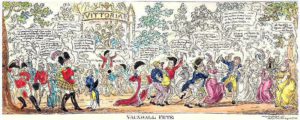
Wellington’s Vittoria Fete at Vauxhall – George Cruikshank, Hand-coloured etching on paper, 1813, The British Museum.
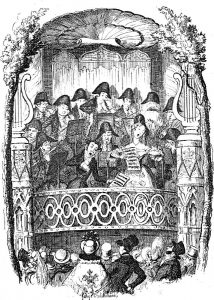
Vauxhall, George Cruikshank, 1739. The Victorian Web, Life in London, Philip V. Allingham, Prof of English Emeritus, Lakehead U; Contributing Editor for Canada
Other Pleasure Garden venues include Cremorne, Ranelagh, Cumberland Gardens & Bagnigge Wells, which has evolved from its previous existence as a small spa & tea gardens.
“Over 200 outdoor pleasure gardens & tea gardens proliferated in London from the 16th to the early 19th centuries. Primarily frequented by working class people who lived in the city, they were located in the pleasanter parts of London’s suburbs. In days of yore, the countryside was only a walk, short carriage drive or ferry ride away from the city center. Tea & pleasure gardens afforded the populace a respite from the sights, smells, & congestion of city life.” “18th & 19th Century Pleasure and Tea Gardens in London.” Jane Austen’s World.
“A great deal of company, and the weather and garden pleasant and it is very cheap and pleasant going thither. . . . But to hear the nightingale and the birds, and here fiddles and there a harp, and here a Jew’s trump, and here laughing and there fine people walking is mighty divertising.”— Samuel Pepys.
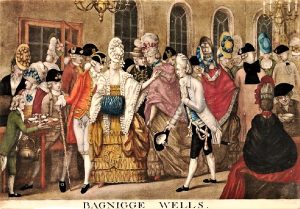
Bagnigge Wells : Long Room of Bagnigge, tea drinkers in macaroni fashion, Trustees of the British Museum
Guests at Bagnigge Wells wear the current macaroni designs. The painting of the Long Room, left, shows what a showcase for fashion the old health spa has become.
“The trend of the macaroni grew out of the tradition of those who partook of the Grand Tour. Elite men in the 18th century would travel abroad across Europe, namely Italy, to broaden their cultural depth. These men adopted foreign fashions and tastes and brought them back to England where they interpreted them further.
Pleasure Gardens at Highbury Barn
Highbury Barn has evolved, with new pleasures added to its attractions. It may not have the grandeur of Vauxhall,, but Londoners now come to rural Highbury seeking more than the fresh air, dairy delights, tea & syllabubs for which it has been known.
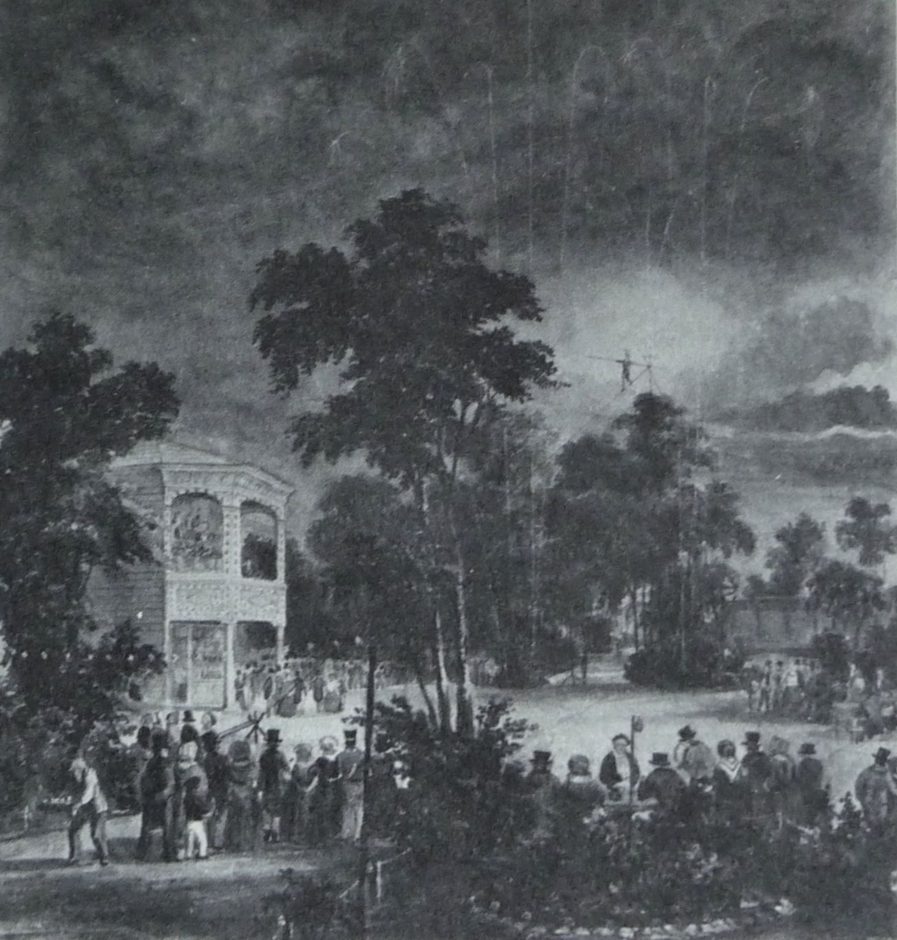
Tightrope walker, fireworks, al fresco dining at Highbury Barn, C.H.Matthews, watercolour, 1850. (GLC Print Collection)
Events staged at the annual balls in the grounds of the Barn include, on the evening of 10th July 1854, a balloon ascent by Charles Green, Britain’s most celebrated aeronaut.
Balloon Ascensions
Tea gardens and pleasure grounds are favoured lift-off points for balloon ascensions. These are early days in the history of flight, and a small number of brave souls put themselves at risk to ascend in baskets dangling from hot air balloons. Balloon ascensions are popular with spectators, drawing the crowds.
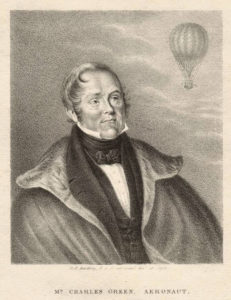
Charles Green, Balloonist. Stipple engraving, 1839 – Pubd by G.P. Harding, Lambeth, Day & Haghe, Lithrs. to the Queen.
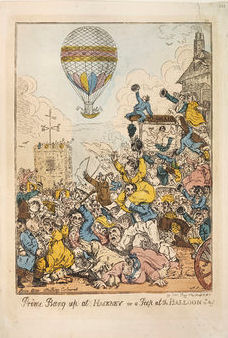
Sadler’s ascent of Aug 12, 1811, Prime Bang-up at Hackney or A Peep at the Balloon, Thomas Tegg, coloured caricature
Charles Green’s ascent from Highbury is one of 500 such balloon ascensions he makes in his lifetime. He was seated on his pony for a documented ascent from The Eagle Tavern on nearby City Road (16 August 1828), descending at Beckenham, Kent after half an hour aloft.
https://howlingpixel.com/wiki/Charles_Green_(balloonist)
http://www.victorianlondon.org/entertainment/ballooning.htmhttp://www.gutenberg.org/file/43526/43526-h/43526-h.htm#page46
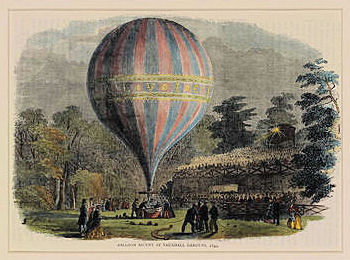
Balloon Ascent at Vauxhall Gardens, Charles Green’s Royal Victoria Balloon, engraving, 1849, V&A collection.
“This whole area would have been like one great resort with balloon rides, archery, races, bandstands, cricket and concerts.” John Rogers, The Lost Byway, Looking for the Lost Pleasure Gardens of Islington, 2004.
Pleasure Gardens on the Decline
The anonymous writer of the “Sunday Ramble” describes The White Conduit, no longer the venue it once had been :
In 1826 a “Minor Vauxhall” was established here, and the place became somewhat disreputable. Mr. Chabert, the fire-eater, after a collation of phosphorus, arsenic, and oxalic acid, with a sauce of boiling oil and molten lead, walked into an oven, preceded by a leg of lamb and a rump-steak, and eventually emerged with them completely baked, after which the spectators dined with him. Graham also ascended from these gardens in his balloon. In this year Hone talks of the gardens as “just above the very lowest,” though the fireworks were as good as usual.
About 1827 archery was much practised; and in 1828 the house was rebuilt with a great ball-room and many architectural vagaries. A writer in the Mirror of 1833 says, on the decline of The White Conduit (Pentonville) :—
“Never mind Pentonville, it is not now what it was, a place of some rural beauty. The fields behind it were, in my time, as wild and picturesque, with their deep-green lanes, richly hedged and studded with flowers, which have taken fright and moved off miles away— and their ‘stately elms and hillocks green,’ as they are now melancholy and cut up with unfurnished, and, of course, unoccupied rows of houses… The march of town innovation upon the suburbs has driven before it all that was green, silent, and fitted for meditation.
Being now a popular haunt, those who hang on the rear of the march of human nature, the sutlers, camp-followers, and plunderers, know that where large numbers of men or boys are in pursuit of pleasure, there is a sprinkling of the number to whom vice and debauchery are ever welcome; they have, therefore, supplied what these wanted, and Pentonville may now hold up its head, and boast of its depravities before any other part of London.”
http://www.british-history.ac.uk/old-new-london/vol2/pp279-289
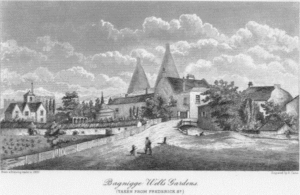 Bagnigge Wells… “became a threepenny concert hall, attracting the lower end of the spectrum. And then it fell out of fashion altogether. Maybe because the public found that the Fleet River was no more than a public cess-pit, or wondered if the cholera epidemics were in some way linked to drinking the putrid waters…
Bagnigge Wells… “became a threepenny concert hall, attracting the lower end of the spectrum. And then it fell out of fashion altogether. Maybe because the public found that the Fleet River was no more than a public cess-pit, or wondered if the cholera epidemics were in some way linked to drinking the putrid waters…
It spent a while as an area notorious for assignations and unseemly conduct – and then it disappeared from view altogether.” Its owner was bankrupted when developers of nearby housing contrived to use the health-giving spring waters as a cesspit.
‘ The Rise and Rise and the Decline and Fall of Bagnigge Wells’, Journal of a Georgian Gentleman blog, Mike Rendell, Kindle Edition
Highbury Barn: Problems with the License
In 1854 there is dancing every evening from seven until half-past ten, with music provided by the band of the Grenadier Guards. At the end of the season the renewal of the dancing license is refused by the magistrates.
The much-contested license for dancing is again granted in October 1956, & in 1858 the ‘Leviathan’, a huge 4,000 foot square open-air dance platform is built to accommodate the dancers. There is a decline in the reputation of Highbury Barn – as with other pleasure gardens, the lateness of the opening hours brings more opportunities for drunkenness, pickpockets & prostitution. In these days of bouncers and security, we can only imagine how difficult it was at the time to maintain the good reputation of a place such as this, The Pride of Merrie Islington, without such protection.
The Bow Street Runners, the first modern police force, is created in 1829. By 1856, even rural communities are compelled to have their own police force. Any law enforcement for Highbury would have had to spend an inordinate amount of its time policing the Barn and its late-night pleasures.
Other Pleasure Grounds have lost their lustre. Vauxhall Gardens, the grandest of them all, has problems with its ‘dark walks’… its gates are shuttered for good in 1859, but Highbury Barn carries on.
During its heyday, Highbury Barn‘s late-night events & noise are well away from people’s homes as it sits surrounded by five acres of fields & farmland. But from 1860, street after street of terraced housing is being built on land surrounding the Pleasure Gardens. Those living in the new houses and villas may have to get up for work in the morning…
Mr Edward Giovanelli : The Barn’s final years
In May 1861, Mr Edward Giovanelli takes over the lease for the Highbury Barn Pleasure Gardens. He constructs a new music hall. He engages the famous gymnast Leotard for the whole of the season of 1862. In 1865 he has the music hall converted into a theatre, the Alexandra, where he himself takes part in performances such as ‘The Hypocrite, The Lottery Ticket‘ (in which he plays Wormwood), & ‘Mother Goose‘ (Grimaldi’s pantomime) in which he plays Clown.
The Grimaldi Mother Goose lasted until 1802 when the modern ‘Dan Leno’ version was adopted. Grimaldi was born in Islington, & the pantomime would have been a tribute to this most famous of clowns, who died in 1837.
Joseph Grimaldi: King of Clowns – Jane Austen.co.uk
2013 : “London’s most peculiar church service takes place on the first Sunday of February each year as hoards of clowns congregate at Dalston’s Holy Trinity Church. Now in its 67th year, the annual Clowns’ Church Service remembers the great Georgian gagster Joey Grimaldi, the inventor of the modern clown, who died in 1837. Around 60 clowns, harlequins, jesters and pierrots of all shapes and sizes assemble in a colourful mass of big feet, rubber noses, curly wigs, whoopee cushions and painted faces to pay their respects to Grimaldi and to light a candle for contemporary clowns who have died over the last 12 months. The service is followed by a clown show for children in the church hall. Londonist
By 1865 entertainments at Highbury Barn include a musical festival, tightrope walking, fireworks, ballet & the original Siamese twins. The Leviathan Dance Platform is enhanced with the light of half a million lamps.
.
In 1868 Blondin, world famous French daredevil acrobat & tightrope walker, performs at Highbury Barn. See the Smithsonian Magazine for details of his exploits crossing Niagara Falls in 1859.
https://www.smithsonianmag.com/history/the-daredevil-of-niagara-falls-110492884/
Blondin: His Life and Performances, Edited by G. Linnaeus Banks. London, New York: Routledge, Warne and Routledge, 1862.
In his blog The Cat’s Meat Shop, author and Victorian London historian Lee Jackson includes a piece from 1865, ‘A Night Out in Highbury’. James Inches Hillocks writes of ‘My Life and Labours in London, a step nearer the mark’, in which on one night he leaves a YMCA meeting at The Priory, Islington and walks along Upper Street towards Highbury Barn Pleasure Grounds. On the way he meets crowds of people in every stage of intoxication.
Closer to The Barn, he finds that it costs ‘a penny-a-head to use the weighing machine… There, too, were the vendors of moustaches and paste-board noses, of all shapes and colours, “for the small charge of one penny.” The moustache and the nose serving as a kind of mask, to give a striking appearance on entering the pleasure grounds, and to disguise the wearers so as to allow more license in their speaking and acting while there.’
The Cat’s Meat Shop
http://catsmeatshop.blogspot.com/2010/10/highbury-barn.html
See also Dirty Old London: The Victorian Fight Against Filth, Lee Jackson, Yale University Press, 2014.
Now, each year when Highbury Barn’s license comes up for renewal, there is opposition from the locals. The Pleasure Gardens have become a noisy & notorious neighbour. “After a riot led by students from Bart’s Hospital in 1869, locals complain about the Barn’s increasingly riotous and bawdy clientele.”
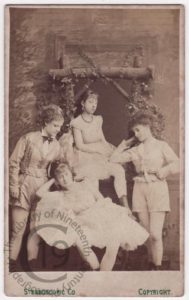
The Colonna Troupe, Library of Nineteenth-Century Photography, London Stereoscopic and Photographic Company
The Colonna Troupe
In June 1870 Mr Giovanelli engages a dance group who are appearing in London and Paris. The ‘Parisian Colonna’ Troupe (Misses Colonna (Newman), Wright, Gerrish & a fourth dancer yet to be identified) come to Highbury Barn, where they perform a shockingly rude version of the new French Can-Can. The audience is scandalized, & Mr Giovanelli’s next application for renewal of the pleasure grounds’ dancing license is refused by the magistrates.
“The exact nature of the ‘objectionable dancing’ of the Colonna Troupe which so outraged the new respectable Victorian residents, forming the last straw that broke the camel’s back, can only for want of evidence be left to the reader’s imagination.” Keith Sugden, History of Highbury
Later that year the Colonna Troupe perform in central London at the Alhambra, Leicester Square. Their dance routine outrages audiences here as well, & in October 1870 the Alhambra too has its dancing licence revoked.
http://www.liquisearch.com/alhambra_theatre/history/entertainments
The Highbury Working Transcribed (Part 3): ‘Pepper’s Ghost’ (2001).
Sketches by Alan Moore
This is part of an online website, a blog of an audio recording by British author & comic book writer (Marvel Comics, DC Comics, Watchmen) Alan Moore, done in 2001 & translated by Jody Macgregor. It takes you into the declining years of the Pleasure Grounds Era: you are there at Highbury Barn in the midst of it all. Compare & contrast with Dickens‘ ‘Sketches by Boz’ above, set in a Sunday afternoon Tea Garden.
” Rising from the Priory’s ash; the Highbury Barn, a tavern in five acre
grounds with bowling greens and trap-ball<?> alleys, haunt for Walter
Raleigh<?>, for Oliver Goldsmith on his walks to Islington. In 1861 a
defrocked clown, Giovanelli, buys the barn, imports a freakshow,
builds the Alexandra Theatre and crams the fog with lamps and voices.Giovanelli launches eel-pie fairs, sewer scampy<?> served on croot<?>,
rat killing contests, ballrooms, and the magical perfume of quim upon
the breeze.A million lights.
His freakshow opens 1869, the city’s dreams and visions are
precipitated in an eerie haze…Highbury becomes a high-risk borderland, a mauve zone, a condition
that could spread, infect the city.The venue is closed down as an intolerable
nuisance, as a danger to the health and safety of the young. The
luscious creepiness is dissipated and the area becomes a void, invites
untested energies
invites
a new
miasma. “
https://groups.google.com/forum/#!topic/alt.comics.alan-moore/2Boo1iXVoAk
Highbury Barn is Closed
Highbury Barn loses its license as an entertainment venue in 1870. The scandalous dancing of the Colonna Troupe appears to have been the last straw. The owner, Mr Edward Giovanelli, is ruined, having reportedly spent £35,000 on the Pride of Merrie Islington.
Mr E B Smith attempts to keep the franchise open, without the objectionable dancing, but the license is refused in October 1871, and all the various venues boarded up. The Pleasure Gardens are history. Keith Sugden, History of Highbury
https://search3.openobjects.com/mediamanager/islington/directory/files/tour_of_islington.pdf ~ A seven-mile bicycle ride round Islington using safe cycle lanes, with fascinating facts about the borough ~
Since the close of the Pleasure Grounds, Highbury is now known primarily for its famous football team, the Arsenal.
The former Highbury Manor House became a Cake-and-Ale House, evolved into a tea garden & ended its days as a pleasure ground, The Pride of Merrie Islington. The magistrates, by refusing the entertainment license to Highbury Barn Pleasure Grounds, have brought the curtain down on over a century of hospitality & entertainment on this five-acre site.
Looking back, we can see that transport to the venue hardly changed… it was by foot – ‘shank’s pony’ – or by horse, with people paying to be taken by horsse & coach or hansom cab. The horse, after all, was the essential mode of transport for the whole of the country.
“The horse was king, and almost everything grew around him: fodder, smithies, stables, paddocks, distances and the rhythm of our days. His eight miles an hour was the limit of our movements, as it had been since the days of the Romans. That eight miles an hour was life and death, the size of our world, our prison… .” Laurie Lee, Cider with Rosie, Hogarth Press, 1959.
The horse was still king in 1870; motorcars were yet to be invented.
What about the pleasure ground’s clientele? Tastes in fashion changed. In Mr Willoughby’s 1740s, men wore breeches, high stockings, top hats & powdered wigs. In 1795, Prime Minister William Pitt levied a tax on wig powder (made of starch & dried fragrant flowers)… & powdered wigs went emphatically out of fashion. Trousers, as introduced by Beau Brummell, friend of the Regency Prince of Wales, were eventually accepted by men in place of breeches & stockings. The invention of the zipper was yet to come, it was all buttons.
Regency Fashion: Men’s Breeches, Pantaloons, and Trousers / Jane Austen’s World
Wig – Wikipedia
Women wore loose-fitting dresses… as multiple petticoats were added, their appearance on the dance platform changed. The crinoline, a cage structure of metal hoops worn under the skirt, was patented in France & introduced to Britain. It quickly became fashionable. In the 1850s the crinoline was a domed structure… it became pyramid-shaped in the 1860s, & was almost flat in front by 1865.
Crinolinemania: The dangerous Victorian fashion garment that killed around 3,000 women
Crinoline – clothing – Britannica – https://www.britannica.com/topic/crinoline
And the dances which any visitors to the pleasure grounds might be doing also changed. In the 1760s, the Allemande & the Cotillion were in fashion. By the 1790s the London Reel & the Promenade had taken people’s fancy.
The Quadrille was introduced in 1810. We know the of Lobster Quadrille from Alice’s Adventures in Wonderland, but many of us had no idea how it was done. Thanks to Youtube, we can see people dancing the Quadrille. Lewis Carroll’s molluscs & mythical creatures do this dance, bowing to each other, recalling all the complicated steps without treading on anyone’s tail…
‘Will you walk a little faster?’ said a whiting to a snail, ‘There’s a porpoise close behind us, and he’s treading on my tail.’ ‘Will you, won’t you, will you, won’t you, will you join the dance?’
Alice’s Adventures in Wonderland, Lewis Carroll, Macmillan, 1865.
Quadrille: Youtube, https://www.youtube.com/watch?v=3JPrMGiGJdo
The Galop & the Mazurka were in vogue in the 1830s, followed by the Polka in the 1840s. In the mid-1800s the Waltz joined the English Country Dance, the Scotch Reel, the Polonaise & the Two-step. Dance teachers enjoyed teaching each new dance to the public.
Could there be spirits haunting the site? Frustrated former owners – fashion dandies – happy dancers still with visions of happier times on the Leviathan Dance Platform, twirling round to the sounds of The Grenadier Guards?
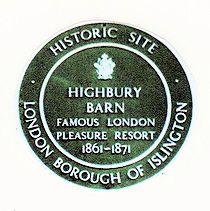 The London Borough of Islington apparently commissioned this plaque to commemorate the site of this rather large London venue, historically important & unique, on the site of the old manor house. The plaque is no longer in situ.What’s happened to it? Should we not have a replacement made? There is a plaque on Highbury Barn Tavern remembering the Peasants’ Revolt 1391, but none for the Pleasure Grounds. There is nothing to even hint at what had existed previously on the site.
The London Borough of Islington apparently commissioned this plaque to commemorate the site of this rather large London venue, historically important & unique, on the site of the old manor house. The plaque is no longer in situ.What’s happened to it? Should we not have a replacement made? There is a plaque on Highbury Barn Tavern remembering the Peasants’ Revolt 1391, but none for the Pleasure Grounds. There is nothing to even hint at what had existed previously on the site.
Taken from ‘London Plaques’ by Derek Sumeray & John Sheppard, Shire Publications. Credit to Alan Patient of www.plaquesoflondon.co.uk See LONDON REMEMBERS page, ‘Aiming to capture all memorials in London’.
***
Cremorne Gardens close in 1877.
Bagnigge House & The White Conduit, with other tearooms and pleasure grounds, are falling out of favour. There are other entertainments now… Londoners are now using the new railways to travel into the countryside and out to the seaside resorts, where there has been a boom in the building of pleasure piers. Places like Brighton now have seaside resort piers featuring many attractions surrounded by a great water feature – there are pavilions, bandstands, rides, fortune-telling automata, foodstalls. It may not have been as grand as Vauxhall, but the Prince of Wales’ Brighton Pavilion was nearby… One might catch a glimpse of him on any visit to Brighton – the local celebrity.
Today’s Highbury Barn, 1885 to date
The Highbury Barn, the pub that stands on part of the original site, retains the name of its famous predecessor. Highbury Barn began life as a cake and ale house on a farm… of all the entertainments that came to be on offer here, it is food & drink that have outlasted all other pleasures. The Highbury Barn is a real ale and food pub.
Has anything of this once famous landmark survived?
In its heyday, The Band of the Grenadier Guards provided the music for the Leviathan Dance Platform. They survived the loss of their North London venue, & perform to this day. The band has various ensembles – Concert Band, Marching Band – their Dance Band ensemble would have been performing at Highbury Barn.
https://webarchive.nationalarchives.gov.uk/20050124223420/
http://www.army.mod.uk/ceremonialandheritage/household/ensembles/ensemble_6.htm
So much history has been lost in Highbury & in the Islington area… & we came close to losing this pub, with all its associations, as well. In 2010, the existing Highbury Barn Tavern was put up for sale by Punch Taverns, who were said to be minded to sell to Sainsbury’s. These are the words of Tony Miller, proprietor of the Barn at the time, in the Highbury Community Association News, issue 67, in June 2010 :
” Towards the end of April it leaked out that Punch Taverns had put the Highbury Barn Tavern up for sale. Then the rumours started flying. It was revealed that Sainsbury’s wanted to convert it into a local supermarket. When an article appeared in the Islington Gazette, Sainsbury’s backed off, but admitted they were “still looking for opportunities” to find premises in the Barn. At the time of writing, the rumour is that a property company is doing a deal to redevelop the Taven. They might create a retail outlet, giving outside interests an “opportunity” to move in.
William Willoughby opened the Highbury Barn in 1770 as a place of entertainment and it flourished for more than a century. The present Highbury Barn Tavern was built on the same site in the 1860s and continued the tradition of hospitality. It’s fair to say that Highbury has grown up around this landmark building. A pub on this site defines Highbury Barn. We can argue about what sort of pub it should be, but we must keep a pub on the site. Nobody refers to this little stretch of road as Highbury Park – though that’s its proper name. We all know it as Highbury Barn.
One of the good things about living in Highbury is the feeling that you are living in a village. At the heart of a village are the village shops. Highbury Barn is mostly composed of owner run, independent shops. We know the owners – and they know us, their customers. We are all part of the community.
.. Any prospective purchaser should be aware that the Highbury Barn Tavern has a special place in the geography, the history and the affections of our community. We will not take kindly to any developer’s attempt to turn Highbury Barn into a carbon copy of every other high street. We will resist that…. most strongly. ” Tony Miller
The HCA represents over 900 residents & businesses on all aspects of living & working in Highbury, Lower Holloway & Finsbury Park. email hcanews@hotmail.com or write to PO Box 43396, N5 9AD.
The current manager of The Highbury Barn, Tony Bedwell, was interviewed by blogger Nicola Baird in February 2014. Worth a read, perhaps followed by a visit to the pub.
islingtonfacesblog.com/2014/…/tony-bedwell-highbury-barn-pub-manag…19 Feb 2014
THE BALLAD OF HIGHBURY BARN
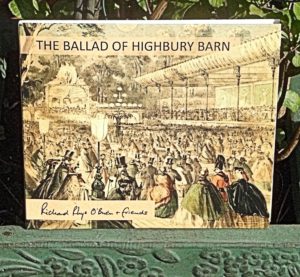 Released for Christmas 2018, this CD by Richard Rhys O’brien, local resident, singer/songwriter & economist, remembers & celebrates the Highbury Barn Pleasure Gardens. Drawing on over 150 years of its existence, Richard has written 18 songs, all performed with friends from Highbury’s Eclectic Voices & musicians from the Harmony Orchestra. The CD comes with a full-colour 38-page booklet of illustrations, maps & lyrics to the songs.
Released for Christmas 2018, this CD by Richard Rhys O’brien, local resident, singer/songwriter & economist, remembers & celebrates the Highbury Barn Pleasure Gardens. Drawing on over 150 years of its existence, Richard has written 18 songs, all performed with friends from Highbury’s Eclectic Voices & musicians from the Harmony Orchestra. The CD comes with a full-colour 38-page booklet of illustrations, maps & lyrics to the songs.
Proceeds from sales, £3,500, went to the Mayor’s Charities, Freightlliners Farm & CARIS Islington.
https://www.facebook.com/RichardRhysOBrien/
Prints and watercolours, esp. of Vauxhall and Bagnigge Wells, included in: Early British & American Public Gardens & Grounds: August 2013
More on Bagnigge Wells: Lost Bagnigge | London Sewers & London’s Main Drainage | sub-urban.com
- Look into the history of your own neighbourhood and local area. We have discovered so much that happened here, in our bit of North London; now thanks to the internet many untold stories can be shared. When you walk out onto your high street, knowing some of what has gone before, you look at it differently.
